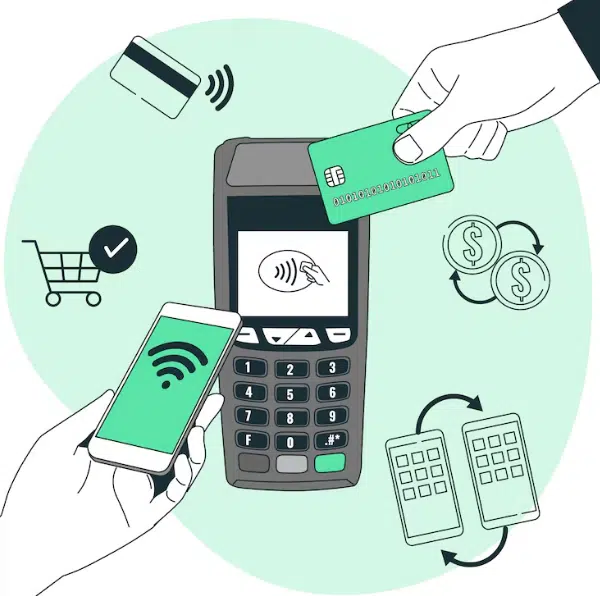In recent years, the expansion of contactless payment options in the US has sparked a significant shift in how Americans transact daily. With the rise of digital wallets and tap-and-go technologies, many are questioning the future of cash. As society becomes more comfortable with these innovations, contactless payment is rapidly becoming a preferred method for many consumers and businesses alike. In this blog post, we’ll delve into the growth of this convenient payment form, assess its implications on the traditional use of currency, and explore whether this trend suggests a future without cash.
As this technology continues to evolve, its adoption is being fueled not only by convenience but also by safety and speed—two factors that gained heightened importance during the COVID-19 pandemic. Retailers across the United States have increasingly upgraded their point-of-sale systems to accommodate contactless transactions, while banks and card issuers now prioritize the release of tap-enabled cards. This infrastructure shift, combined with growing consumer demand for seamless experiences, is laying the groundwork for a broader transformation in the way financial exchanges occur.
The rise of touch-free transactions
Contactless payment solutions have gained remarkable traction in the United States, reshaping the retail landscape and altering consumer habits. Over the past decade, digital wallets and near-field communication (NFC) empowered credit cards have surged in popularity, offering consumers a faster way to pay. The COVID-19 pandemic expedited this shift, as safety-conscious individuals sought ways to make purchases without physical contact.
Reports suggest that a growing segment of the population now prefers to carry little to no cash at all. Many Americans, particularly younger demographics who are more tech-savvy, are increasingly embracing electronic methods for convenience and security. Contactless payment methods not only streamline the shopping experience but also reduce the time spent waiting in lines, making it appealing to consumers constantly on the go.
Technological advancements driving change
The role of technology cannot be overstated in the surge of contactless payment methods. Innovations in NFC technology and the ubiquitous presence of smartphones have fueled a perfect storm, facilitating increased adoption of touch-free payments. Digital giants like Apple, Google, and Samsung have developed their versions of digital wallets, allowing users to readily store card information securely on their devices for easy tap transactions.
The entry of fintech companies into the financial sector has further amplified the reach of these technologies. With an emphasis on providing user-friendly, secure solutions, fintech firms are at the forefront of transforming traditional banking and payment landscapes. Features such as biometric authentication and encrypted transactions have made these systems not only convenient but also appealing regarding data security.
Consumer behavior and market adaptation
Consumer behavior is a critical factor in the shift towards contactless payments. As people grow accustomed to instantaneous reward and satisfaction in other areas of technology, the demand for immediate, hassle-free financial transactions has become paramount. In addition to speed and convenience, safety is a substantial motivator. Many consumers regard contactless payments as a more secure way to manage transactions, given the reduction in physical contact with shared surfaces.
Market adaptation plays an essential role in facilitating this transformation. Retailers, small businesses, and even service providers are quickly recognizing the need to accommodate these new payment preferences. They have started to update their systems to provide NFC-enabled terminals and seamlessly integrate with digital payment platforms. This adaptation not only satisfies consumer demands but also aligns businesses with emerging trends, providing a competitive edge.
Implications for cash and traditional banking
The expansion of contactless payment raises essential questions about the fate of cash in the modern economy. While cash is unlikely to disappear entirely in the foreseeable future, its role continues to diminish in relevance. Some argue this transition could predominantly lead to the reduction of cash-based transactions, with specific demographics and sectors maintaining loyalty to traditional currency. Traditional banking institutions are compelled to reassess their role and adapt to this sea change in consumer preferences.
Many banks have responded by enhancing their digital offerings, providing integration with contactless payment systems, and ensuring their customers can transition seamlessly to a digital-first world. As financial processes continue to evolve, banks must anticipate and innovate in alignment with these technological advancements. Ultimately, while cashless transactions will likely dominate day-to-day interactions, the total elimination of cash is complex, intertwined with regulatory, cultural, and economic factors.
Economic and social impact
As contactless payments gain traction, the economic and societal implications are noteworthy. The convenience and efficiency associated with digital payment methods can stimulate consumer spending, contributing positively to economic growth. Retailers benefit from faster transaction times and improved customer satisfaction, which can lead to increased sales and profitability. However, the transition also brings potential challenges, particularly regarding financial inclusion.
Not all individuals have equal access to the technology required for contactless payments, raising concerns about potentially broadening the digital divide. Efforts to make technology more accessible and ensure inclusive infrastructure are crucial to maximizing benefits while minimizing adverse effects. The societal acceptance of digital payments reflects broader shifts in trust and technology reliance, patterning a significant alteration in lifestyle and commerce.





